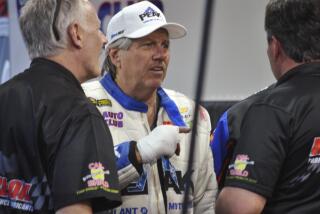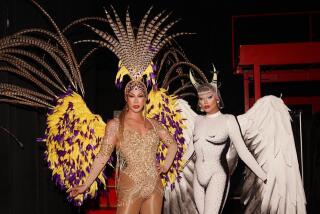At 90, NHRA Founder Is Still a Slick Operator
Wally Parks, founder of the National Hot Rod Assn. and chairman of the board of the NHRA Motorsports Museum, turned 90 on Jan. 23. Still as ramrod straight as he was when he raced hot rods on desert dry lakes 70 years ago, Parks’ presence in drag racing looms as large as the 7-foot statue of him at the museum entrance. Over lunch near his home in Glendale, Parks expressed some thoughts about his sport:
Question: Where do you think drag racing stands in the world of motor sports?
Answer: With all due respect, when are people going to stop fawning over Formula One, a sport that hopes to muster as many as 18 cars for its season? And the same goes for CART, which has to ante up $20 million to help ensure 18 to 20 cars a race. That is ludicrous. The entertainment and commercial value of both racing forms has receded continually in recent years. Neither offers a form of contestant vehicle that resembles anything the public can purchase.
In sharp contrast, one of the toughest challenges for the NHRA is to control the number of would-be entries in its national and divisional events. The U.S. Nationals at Indianapolis has almost 1,000 cars, and the 22 other major events average from 500 to 800. And a high percentage of vehicles are brand identifiable. As evidenced by the number of decals displayed on sides of race cars, drag racing probably has more participating sponsors than any other motor sports activity.
Q: What do you see in the future for drag racing?
A: I have learned that there are very few limits on what can be accomplished. In our pioneer days, 100 mph was our objective. Now, on the same size quarter-mile course, they are running 330 mph. Not long ago, we put up barriers in hopes of preventing 300-mph runs for safety purposes, but it only postponed the inevitable. The nature of drag racing is that nothing is unattainable and our safety program has matched our speeds.
Q: In 2000, Tom Compton became only the third president of NHRA in 50 years. He swept aside many old-timers in the organization and replaced them with his own cadre of people with little or no racing background. What is your feeling about that?
A: It was painful at first to lose older staff members who grew up in the sport and see them replaced by people not associated with the sport, who did not know how we did things all those years. However, the personnel Tom brought in, with their emphasis on marketing and sales, has proved very satisfying.
Let me say something else about Tom Compton. He gets credit for a lot of courage in making two important changes in our racing program, two very unpopular changes at the time. He announced severe penalties for oil-downs that delayed racing, and he cut the time between runs from 90 to 75 minutes. Both were designed to streamline our race-day schedule, and both proved successful, despite early opposition from drivers and crews. He has accomplished a lot despite a lot of ill feeling toward the new regime.
Q: At 90, what is your role with the NHRA today?
A: I am still on the board of directors and I’m not afraid to make recommendations when I see something I think is needed. I am also chairman of the board for the NHRA museum, which is a wonderful project that we worked a long time developing. I don’t go to as many races as I once did, but I make some, especially at Pomona.
I had a streak of 109 races when I decided to stay home one time when we were racing in Gainesville, Fla. All day long I kept wondering if I was missed. I still enjoy going to the races to see the amazing quality and variety of unique entries.
Q: Your wife Barbara has been an important partner in the formation of the NHRA. Did her presence bring more wives into the sport’s leadership?
A: Definitely. When we were starting out, we found that it was important to involve wives of staff members. There was so much travel involved, it helped when wives understood the reasons. Some wives became key principals, more so than their husbands.
Barbara was my secretary when I became the first editor for Hot Rod magazine. On her first day, I told her she might be busy with extra work on a new project I had in mind, which turned out to be the NHRA, so she was our first employee, so to speak.
Q: What have been the key elements in the growth of the NHRA?
A: There have been so many I hardly know where to begin. At first, Jack Hart, our vice president, and Bob Russo, our publicist, broke a lot of ground.
Later, television brought us exposure and the R. J. Reynolds Tobacco Co., with its Winston brand, contributed not only big sums of money, but also spearheaded a campaign to upgrade racing facilities all over the country. Then Dallas Gardner became our second president and he used his financial background to steer the NHRA to a stronger position.
Then, of course, there are the racers. Guys from Don Garlits to John Force, especially Don Prudhomme and Kenny Bernstein and Shirley [Muldowney], became household names and that helped tremendously. When you consider the conditions Garlits worked under, it’s just fantastic what he accomplished. His records have been broken, but you must remember what he had to work with, which was virtually nothing compared to the resources Force has today.
Q: If you could make a major shift in drag racing for the future, what would it be?
A: It would be to run many of our events on eighth-mile tracks, like Irwindale, instead of the traditional quarter-mile. I have tried to tell people, especially the import and nostalgia racers, that 660 feet, instead of 1,320, is far enough to show off their technology and speed and it would save a lot of money and equipment. Races are usually won off the starting line and engines are more likely to blow up toward the end.
It’s an idea that seems so logical to me, but so far I can’t sell it as a national standard. An eighth-mile track also takes up a lot less real estate. Someday it will happen and racers will look back and wonder why it hadn’t happened sooner.
More to Read
Go beyond the scoreboard
Get the latest on L.A.'s teams in the daily Sports Report newsletter.
You may occasionally receive promotional content from the Los Angeles Times.










